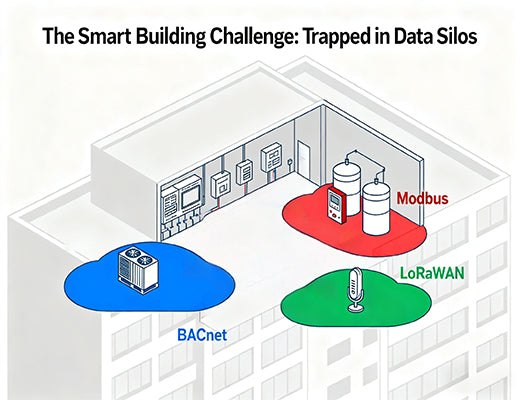
The BACnet Edge Gateway: Your Guide to Smart Building Integration
|
|
Time to read 5 min
|
|
Time to read 5 min
A modern IoT edge gateway is the key to unlocking the data trapped in legacy building automation systems. By acting as a powerful protocol translator, a BACnet edge gateway can seamlessly bridge older, wired systems (like BACnet MS/TP and Modbus) with modern wireless sensors (like LoRaWAN) and cloud platforms. This guide explains how this integration breaks down data silos, enabling unified building control, improved energy efficiency, and proactive maintenance without a costly "rip and replace" of existing infrastructure.
Many commercial buildings run on reliable but disconnected legacy automation systems, creating "data silos" that prevent true smart building functionality.
An IoT edge gateway acts as a "universal translator," speaking dozens of protocols like BACnet/IP, BACnet MS/TP, Modbus RTU, and LoRaWAN to unify all building data.
This integration allows facility managers to overlay modern IoT sensors and analytics onto existing BMS infrastructure, drastically lowering the cost of modernization.
The result is a single, unified, data-driven view of the entire building, which is the foundation for advanced energy optimization and predictive maintenance strategies.
I was recently talking to a facility manager of a 20-year-old office building. He had a rock-solid, reliable HVAC system that he trusted completely. His problem? It ran on an older BACnet MS/TP serial network and couldn't talk to anything modern. He wanted to add new, wireless LoRaWAN occupancy sensors to save energy in empty rooms, but his expensive, legacy Building Management System (BMS) and the new IoT sensors spoke completely different languages.
He felt stuck, forced to choose between his reliable old system and the promise of new smart technology.
Let's be clear: you don't have to choose. You can have both. The solution is to hire a translator. In the world of building automation, that translator is a modern, protocol-agnostic IoT edge gateway. This guide will show you how a BACnet edge gateway can bridge the past and the future of your building.

The scenario above is incredibly common. A typical commercial building is a patchwork of systems from different vendors, installed at different times, all speaking different languages (protocols).
These systems all operate in their own isolated worlds, creating "data silos." You can't have a truly "smart" building if your systems can't talk to each other.
The real 'aha!' moment for system integrators is realizing that a modern edge gateway is the "Rosetta Stone" for building automation. Its primary job in this scenario is protocol conversion.
A powerful edge gateway with advanced middleware (like Robustel's E2C Pro) is designed to be multilingual. It can simultaneously:
It takes the data from all these disconnected silos and translates it into a single, clean, standardized data stream.

Let's walk through our facility manager's problem. Here's how a BACnet edge gateway solves it.
An engineer connects the gateway's RS485 serial port directly to the BACnet MS/TP bus of the existing HVAC controllers. The gateway is configured to act as a BACnet device, polling the controllers for data like temperature setpoints, fan status, and energy usage.
The gateway then sends a single, unified data stream—containing both the HVAC status and the occupancy data—via MQTT to a central BMS dashboard or cloud platform. Now, the facility manager can visualize energy usage against actual room occupancy for the first time.

Modernizing your building's automation system doesn't have to mean a costly and disruptive "rip and replace" project. By using a powerful, protocol-agnostic BACnet edge gateway, you can bridge the past and the future of your building. It's the key to breaking down data silos, preserving your investment in reliable legacy systems, and creating a truly intelligent, efficient, and data-driven smart building.
Learn more in our main guide:
A1: BACnet (Building Automation and Control Networks) is a communication protocol specifically designed for building automation systems. It's the de facto standard for how devices like HVAC controllers, lighting systems, and security systems from different manufacturers communicate with each other.
A2: They are two different "layers" of the BACnet protocol. BACnet/IP runs over standard Ethernet IP networks and is typically used for communication between main controllers and server-level systems. BACnet MS/TP (Master-Slave/Token-Passing) runs over a serial bus, almost always RS485, and is very common for the field-level networks that connect the main controllers to the individual thermostats, sensors, and actuators.
A3: Not necessarily. While a full SDK for languages like Python is available for complex custom applications, many modern edge gateways and middleware platforms (like Robustel's E2C Pro) utilize low-code tools like Node-RED. This allows you to create data flows, protocol translations, and logical rules using a graphical, drag-and-drop interface.